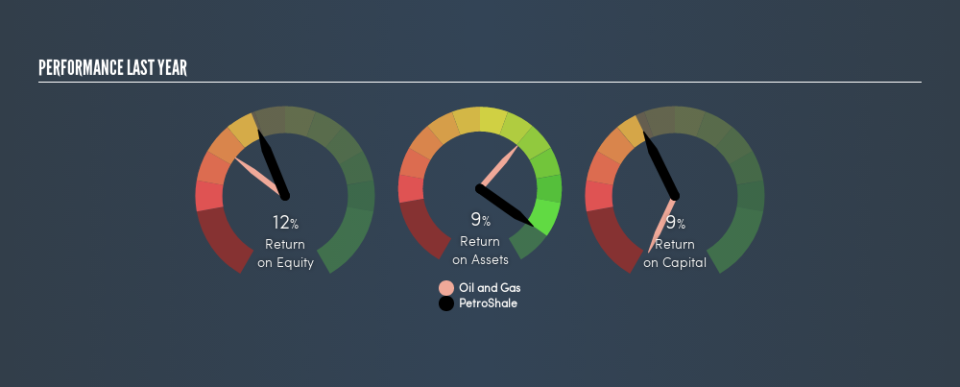A Close Look At PetroShale Inc.’s (CVE:PSH) 8.9% ROCE

Today we'll evaluate PetroShale Inc. (CVE:PSH) to determine whether it could have potential as an investment idea. Specifically, we'll consider its Return On Capital Employed (ROCE), since that will give us an insight into how efficiently the business can generate profits from the capital it requires.
Firstly, we'll go over how we calculate ROCE. Next, we'll compare it to others in its industry. Finally, we'll look at how its current liabilities affect its ROCE.
Return On Capital Employed (ROCE): What is it?
ROCE measures the 'return' (pre-tax profit) a company generates from capital employed in its business. All else being equal, a better business will have a higher ROCE. Overall, it is a valuable metric that has its flaws. Renowned investment researcher Michael Mauboussin has suggested that a high ROCE can indicate that 'one dollar invested in the company generates value of more than one dollar'.
How Do You Calculate Return On Capital Employed?
The formula for calculating the return on capital employed is:
Return on Capital Employed = Earnings Before Interest and Tax (EBIT) ÷ (Total Assets - Current Liabilities)
Or for PetroShale:
0.089 = CA$33m ÷ (CA$429m - CA$61m) (Based on the trailing twelve months to March 2019.)
Therefore, PetroShale has an ROCE of 8.9%.
Check out our latest analysis for PetroShale
Does PetroShale Have A Good ROCE?
ROCE is commonly used for comparing the performance of similar businesses. PetroShale's ROCE appears to be substantially greater than the 6.1% average in the Oil and Gas industry. I think that's good to see, since it implies the company is better than other companies at making the most of its capital. Setting aside the industry comparison for now, PetroShale's ROCE is mediocre in absolute terms, considering the risk of investing in stocks versus the safety of a bank account. It is possible that there are more rewarding investments out there.
PetroShale delivered an ROCE of 8.9%, which is better than 3 years ago, as was making losses back then. That suggests the business has returned to profitability. The image below shows how PetroShale's ROCE compares to its industry, and you can click it to see more detail on its past growth.
When considering ROCE, bear in mind that it reflects the past and does not necessarily predict the future. ROCE can be misleading for companies in cyclical industries, with returns looking impressive during the boom times, but very weak during the busts. ROCE is, after all, simply a snap shot of a single year. Remember that most companies like PetroShale are cyclical businesses. Since the future is so important for investors, you should check out our free report on analyst forecasts for PetroShale.
What Are Current Liabilities, And How Do They Affect PetroShale's ROCE?
Liabilities, such as supplier bills and bank overdrafts, are referred to as current liabilities if they need to be paid within 12 months. Due to the way ROCE is calculated, a high level of current liabilities makes a company look as though it has less capital employed, and thus can (sometimes unfairly) boost the ROCE. To counteract this, we check if a company has high current liabilities, relative to its total assets.
PetroShale has total liabilities of CA$61m and total assets of CA$429m. As a result, its current liabilities are equal to approximately 14% of its total assets. It is good to see a restrained amount of current liabilities, as this limits the effect on ROCE.
The Bottom Line On PetroShale's ROCE
That said, PetroShale's ROCE is mediocre, there may be more attractive investments around. But note: make sure you look for a great company, not just the first idea you come across. So take a peek at this free list of interesting companies with strong recent earnings growth (and a P/E ratio below 20).
I will like PetroShale better if I see some big insider buys. While we wait, check out this free list of growing companies with considerable, recent, insider buying.
We aim to bring you long-term focused research analysis driven by fundamental data. Note that our analysis may not factor in the latest price-sensitive company announcements or qualitative material.
If you spot an error that warrants correction, please contact the editor at editorial-team@simplywallst.com. This article by Simply Wall St is general in nature. It does not constitute a recommendation to buy or sell any stock, and does not take account of your objectives, or your financial situation. Simply Wall St has no position in the stocks mentioned. Thank you for reading.

 Yahoo Finance
Yahoo Finance 
